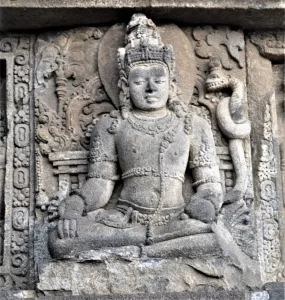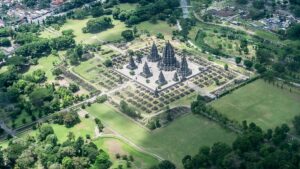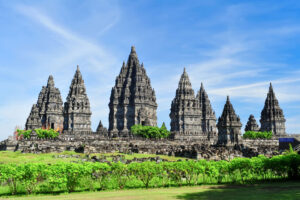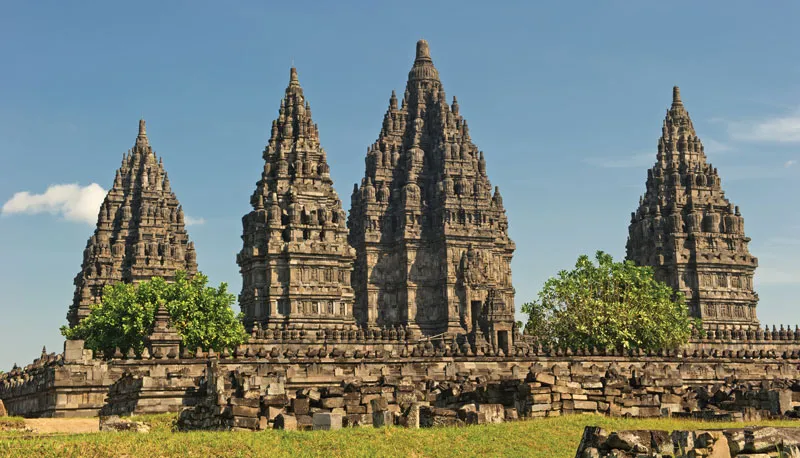A Monument of Devotion, Power, and Timeless Architecture
Located in Central Java, Indonesia, the Shiva Temple at Prambanan stands as a stunning testament to ancient Hindu architecture and religious devotion in Southeast Asia. Known locally as Candi Shiva Mahadeva, it is the largest and most impressive temple in the Prambanan Temple Complex, a UNESCO World Heritage Site and one of the most important Hindu sites outside India.
🌍 Historical Background
Constructed around 850 CE during the rule of the Sanjaya Dynasty, the Prambanan complex was built to honor the Hindu trinity—Brahma, Vishnu, and Shiva—with Shiva receiving the central and most grandiose shrine.
The temple’s creation marked the return of Hinduism as the dominant religion in Java after a period of Buddhist influence, and it was designed to rival the nearby Buddhist Borobudur Temple in scale and magnificence.
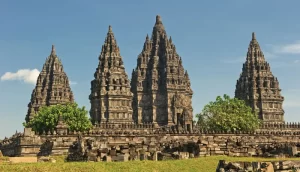
🕉️ The Shiva Temple: Candi Shiva Mahadeva
The Shiva Temple, located at the center of the Prambanan complex, is 47 meters (154 feet) high and is dedicated to Shiva the Destroyer, the most powerful deity of the Hindu Trimurti.
Key Features:
-
Four Chambers:
The main chamber houses a magnificent statue of Shiva Mahadeva, standing nearly 3 meters tall. The other chambers are dedicated to:-
Durga (Shiva’s consort, as Mahisasuramardini)
-
Agastya (a revered sage and Shiva devotee)
-
Ganesha (Shiva’s son, the remover of obstacles)
-
-
Intricate Reliefs:
The temple walls are adorned with detailed Ramayana reliefs, narrating episodes from the ancient Hindu epic. These carvings demonstrate the artistic and spiritual depth of Javanese Hinduism. -
Vertical Symbolism:
The towering vertical structure represents Mount Meru, the mythical axis of the universe in Hindu cosmology, with the temple acting as a divine bridge between heaven and earth.
🛕 Architectural Significance
The Shiva Temple follows the classic Hindu Mandala layout, with symmetrical design and precise orientation reflecting cosmic principles. Constructed from volcanic stone, the temple’s architectural style is both Indian in origin and uniquely Javanese in execution, with elements adapted to the local culture and environment.
Despite centuries of neglect, volcanic eruptions, and earthquakes—including a major one in 2006—the temple still stands as a majestic symbol of Indonesia’s deep-rooted Hindu heritage.
🙏 Cultural and Religious Importance
Though Indonesia is a predominantly Muslim country today, the Prambanan Temple Complex remains an active religious site. Balinese Hindus, who maintain ancient traditions, often visit the temple for religious ceremonies. It also serves as a cultural hub, hosting the Ramayana Ballet performances under the open sky with the temple as a backdrop.
This temple not only reflects Indonesia’s pluralistic past but also promotes intercultural understanding and spiritual connection among modern visitors.
✨ Visiting Prambanan Today
The Prambanan Temple Complex, including the Shiva Temple, is open to tourists and pilgrims year-round. It is easily accessible from Yogyakarta, a city rich in culture and history.
Whether you are a devotee of Lord Shiva, a lover of ancient architecture, or a traveler drawn to spiritual places, the Shiva Temple at Prambanan offers a profound experience that blends mythology, history, and human artistry.
📜 Conclusion
The Shiva Temple at Prambanan is more than a historical monument—it is a living symbol of Indonesia’s Hindu legacy and the universal reverence for Lord Shiva. As one of the most awe-inspiring Shiva temples outside India, it stands as a beacon of divine presence, cultural fusion, and architectural brilliance that has endured for over a millennium.
